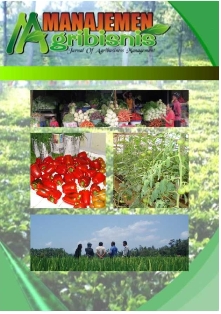Analisis Permintaan Buah Pisang Di Kota Denpasar, Bali
Analisis Permintaan Buah Pisang Di Kota Denpasar, Bali
Abstract
ABSTRACT
Demand Analysis For Bananas In Denpasar City
This study aims at finding out factors influencing demand for bananas and
calculating price, income and cross elasticies of demand for bananas in Denpasar. The
study focuses on household consumers in Denpasar City including 100 respondents.
Data were analyzed using multiple linear regression considering economic,
econometrics and statistics criteria.
Based on the linear regression analysis, the demand model for bananas in
Denpasar is lnY = -43,156 -0,139 lnX1 -0,600 lnX2 -0,378 lnX3 +5,896 lnX4 +0,776
lnX5 +3,365 lnX6 +0,418 lnX7 +0,548 lnD. All independent variables are
simultaneously significant affecting demand for bananas in Denpasar. Partially, prices
of zalacca, rambutan, total income, number of household members, and purpose of
purchasing significantly affecting demand for bananas. Meanwhile, price of bananas,
price of oranges, and price of mangoes do not have significant effect on demand for
bananas. Price elasticity of demand for bananas shows an inelastic figure (e<1),
implying that demand for bananas is not responsive to the price changes. A positive sign
in the value of the income elasticity indicates that banana is a normal good. Sign of the
cross-price elasticity of oranges and mango prices was negative, referring that these
fruits are complementary to bananas. On the other hand, cross-price elasticities of
zalacca and rambutan are positive, meaning that zalacca and rambutan are substitute
commodities to bananas.
Keywords: demand for bananas, regression, elasticity, household, Denpasar













